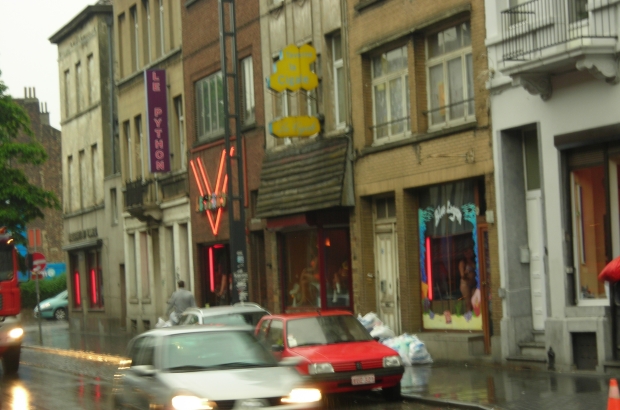- Daily & Weekly newsletters
- Buy & download The Bulletin
- Comment on our articles
Man suspected of killing police officer was on terror watchlist, Brussels red light district to close at night
After a police officer was killed and another was injured in a shooting in Schaerbeek last week, authorities say they are reflecting on the policies and procedures that allowed for the suspect to be on the streets despite a long criminal record and fears of radicalisation.
The suspect appears on Belgium’s terrorist watchlist, and while he was earlier taken by police to a psychiatric hospital, the law states that any person may also leave such a place of their own free will, which the suspect did shortly after being taken there.
The Saint-Luc University Clinic confirmed in a press release that the suspect in the police shooting had indeed come to their emergency room with police officers last week.
But the clinic emphasised that when the police officers left, they “never informed the members of the emergency staff of the danger posed by this person,” who then left the waiting room an hour after having been dropped off, “without having been psychiatrically assessed” but in accordance with the hospital's protocol.
“The clinic would like to point out that any patient who comes to the emergency room is free to leave on his or her own initiative unless he or she is under continuous police surveillance, which was not the case in this admission,” the statement said, explaining that it had not received “any instructions” from the “competent authorities”.
Police officers expressed “incomprehension and anger”, according to RTL, which spoke with the chief of the Brussels-North police zone, Olivier Slosse.
“We could be in a situation where there is no individual mistake but the mistake is in the system,” Slosse said.
“Since the outcome is unacceptable, you can't have a system that results in this kind of thing, so you have to examine that system. The police, the judiciary and the public prosecutor's office are in contact but do not communicate because there is no legal framework.”
The injured police officer was released from hospital over the weekend, and Slosse said the officer’s first reaction was to apologise for not being able to save his colleague, even though the blame clearly lies elsewhere.
Deputy prime minister Georges Gilkinet (Ecolo) suggested an examination of the procedures that were followed and a modification of the current legal framework if needed.
Other leading politicians discussing the matter suggested that other tools could have been used to arrest the suspect, rather than release him out of respect for protocol despite serious concerns regarding the danger he posed – concerns which then proved to be valid.
“In theory, there were threats made to the police during an initial interview in Evere,” said David Clarinval (MR). “Perhaps the magistrate could also have taken him into custody for threats.”
Thomas Dermine (PS) called the murder of one officer and injury of another “the result of insufficient resources. When we hear that a magistrate has to take 100 remote assessments per night, how can we be sure of having a 100% reliable procedure and risk assessment?”
Belgium’s justice minister Vincent Van Quickenborne, however, emphasised that when the man was taken to the psychiatric hospital it was as a patient, not a suspect, and that the man had expressed a desire for help from police officers who then followed the proper protocol.
“[The suspect] made statements to the effect that he wanted to commit an attack but did not want to, that he needed help,” Van Quickenborne said.
“He was arrested, searched, no weapon was found and then the police contacted the public prosecutor's office, with the magistrate on duty who contacted the terrorism magistrate in Brussels and then they checked and collected information.”
Van Quickenborne said that the man had not committed any crimes since being released from prison in 2019.
“He is on the OCAM terror watchlist, but was there any worrying information about this person? The answer was no. We also contacted the anti-radicalism service in his place of residence and on the basis of these elements and because he presented himself at the police station, they decided to refer him to the psychiatric centre.”
But given that the man then left and murdered a police officer and attempted to murder more, few seem convinced of the quality of the information authorities had, or whether it was properly shared across departments, especially in regards to the anti-radicalisation team that was supposedly monitoring the suspect.
A joint justice and home affairs committee meeting is taking place on Monday to assess the situation and determine if there were communication issues between the various groups of authorities involved.
“I hope that this will give us more clarity,” Van Quickenborne said.
As a result of the murder, Brussels' red light district along Rue d'Aarschot, where prostitution takes place, will be closed between the hours of 1.00 and 6.00 for one month, in an effort to reduce tension in the neighbourhood.
“It is a question of putting in place a system that will prevent or control any excesses, particularly at night,” acting mayor of Schaerbeek Cécile Jodogne told reporters.
“These night-time activities are often accompanied by drugs and alcohol. We think that as a temporary measure to restore calm and public safety, we unfortunately have to take this exceptional measure.”



















Comments
It's a real pity that no one at the hospital used their own initiative to get in touch with the authorities to ask for " “any instructions” from the “competent authorities” and keep the man there in the meantime. Sometimes it's necessary to think outside the box and take action, not just react afterwards.